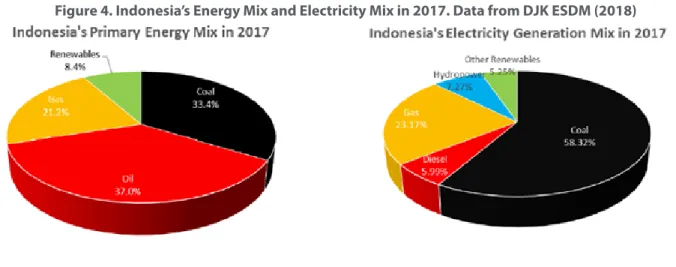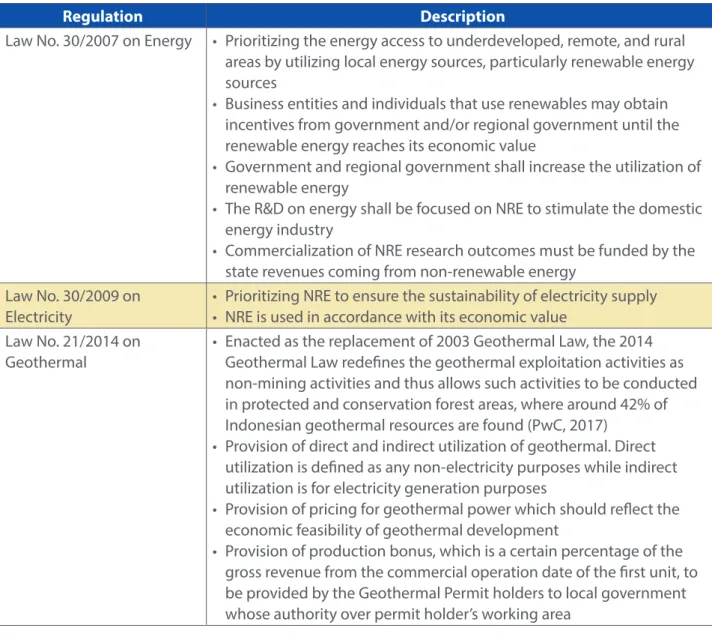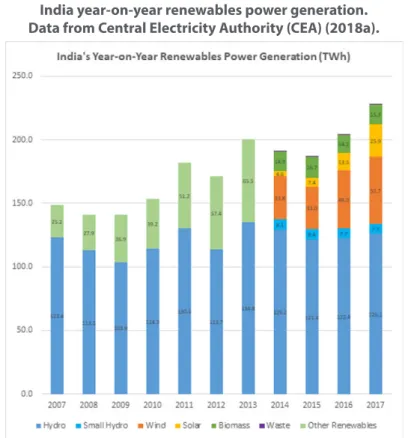The International Renewable Energy Agency (IRENA) states that the rapid deployment of renewable energy (increase from about 15% of primary energy supply in 2015 to 65% in 2050) is one of the essential measures to tackle the challenge. The rapid growth of renewable energy in China over the past decade has been accompanied by a strong stimulus. The strong growth of renewable energy in India is supported by integrated policies adopted over the years.
In the early implementation phase, all countries have established Feed-in Tariff (FiT) policies favoring renewable energy.
Recommendation
Introduction
- National Targets and Programs
Indonesia, a country with more than 260 million inhabitants, is the fourth most populous country in the world and the largest economy in Southeast Asia. The following parts review the Indonesian renewable target and programs, latest development, electricity market, regulatory and institutional frameworks, financial incentives and overall challenges in the development of renewable energy in Indonesia. In order to reduce emissions in its power sector, the Government of Indonesia established the National Energy Policy (KEN) in 2014, setting out targets to increase the share of New and Renewable Energy (NRE) in the primary energy mix to 23% by 2025 and 31% by 2025. increase. .
Since no specific proportions have been determined for the renewable and "new energy", this report assumes that the target will be fully achieved with the renewable energy.
Renewable Energy in Indonesia
- Current Status
- Electricity Market
- Regulatory and
The targets referred to in figure 3 are a mix of committed and potential projects in Indonesia. As demonstrated in the figure 6, the year-on-year capacity addition of renewable energy in Indonesia has decreased since 2013. In fact, the growth of renewable energy in the last decade has been modest compared to the gigantic growth of thermal power plants in Indonesia.
In the generation sector, there are the state-owned enterprise (PLN) which generates most of Indonesia's electricity, Independent Power Producers (IPPs) and Private Power Utilities (PPUs).
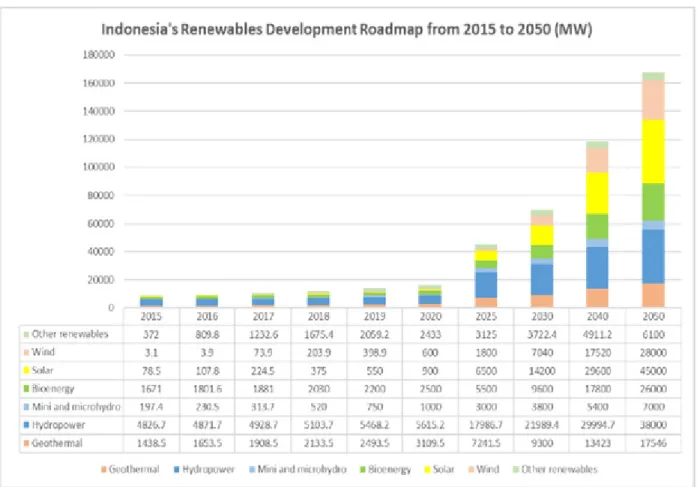
Institutional Frameworks
Financial Instruments and Incentives
Fiscal and Financial IncentivesTable 5
While the renewable energy industry is still emerging in Indonesia, the country needs to stimulate the development of renewable projects. The Indonesian government has provided fiscal and financial incentives for renewable projects in the country since 2010. It also appears that the interest subsidies provided by the government are not helpful in reducing interest rates for renewable developers in Indonesia. .
In addition, unlike banks in other countries, the local banks in Indonesia do not provide project financing scheme to finance renewable projects.
Grid Connection and Tariff Incentives
- Challenges of Renewables Development in Indonesia
- Case Study 1: Renewable Energy Development
However, this limit is detrimental to the development of renewable energy in Indonesia, as the tariffs are considered insufficient to make the renewable projects attractive to investors. In addition, the government must find ways to lower the financing costs of renewable projects in Indonesia. To conclude, the government of Indonesia has failed to address the non-economic barriers in the development of renewable energy in Indonesia.
The transparency, longevity and certainty needed to create an attractive market for renewable energy are lacking, thus hindering the rapid development of renewable energy in Indonesia.
International Experience
- National Targets and Programs
- Current Status
- Nuclear Phasing-out
- Renewable Energy
- Electricity Market
These three countries were chosen because many see them as global leaders in the development of renewable energy. The energy transition program leading to a progressive high development of renewable energy in Germany is essentially a continuous process until now. However, the real start of implementing the energy transition began with the Renewable Energy Sources Act /EEG and related policies.
Over the past 20 years, Germany has significantly diversified its electricity mix towards renewable sources (the share of which has risen from 4% of total energy demand in 1990 to 36% in 2017). The generation mix in Germany mainly consists of conventional and renewable energy sources. At the end of 2017, Germany's total installed capacity was 202 GW, an increase of 5 GW from the.
In the period the share of renewable energy in Germany increased more than four times, both in primary energy consumption and in gross electricity consumption (Figure 13). However, there was a shift of generation mix in the country from conventional energy sources to renewable energy sources throughout the period (Figure 15). According to the definition of renewable energy legislation, wind and solar power enjoy feed-in priority: when wind farms and solar PV produce electricity, they are entitled to feed the power into the grid.
The German system has shown a remarkable ability to flexibly handle the variability of wind and solar energy (11-87% feed-in of renewable energy at specific hours in 2016) and is one of the safest in the world, with a record number of interruptions. Due to the congestion, there is also redispatching of power plants (usually this means that (more expensive gas) plants in the South, where electricity is needed, are switched on, while other, cheaper plants are switched on, Figure 19.
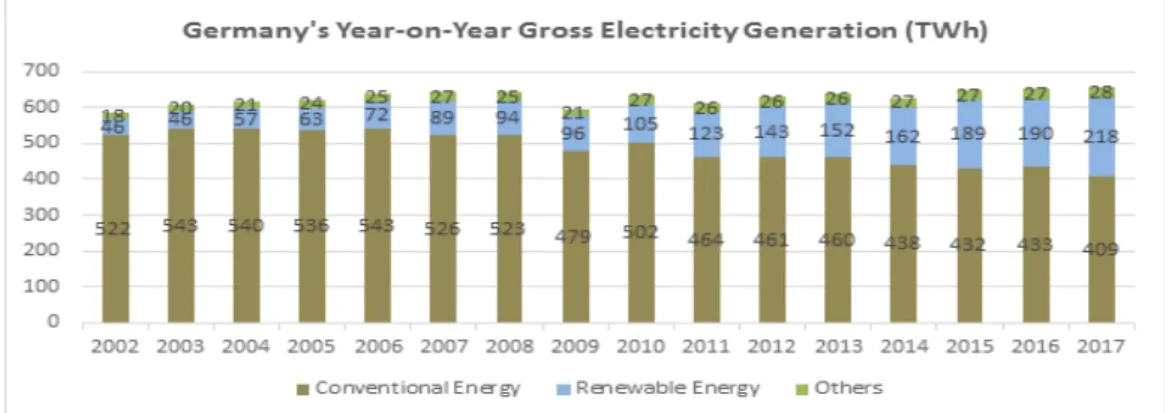
ON RWE
- Regulatory and Institutional Frameworks
- Action Plan on Climate Change
- Renewable Energy Sources Act
- Energy Industry Act
- Electricity Market Act
- Regulations on Grid Expansion
- The Act on the Digitization of the Energy Transition (Gesetz zur
- Financial Instruments and Incentives
- Key Lessons
- Case Study 2: Renewable Energy Development in
- National Targets and Programs
- Current Status
- Electricity Market
- Regulatory and Institutional Frameworks
- The Renewable Energy Law
- Medium and Long-Term Development Plan for Renewable Energy
- Renewable Energy Five Year Plans
- Financial Instruments and Incentives
- Research and Development (R&D) Incentives
- Fiscal and Tax Incentives
- Grid connection and Tariff Incentives
- Market Development Incentives
- Key Lessons
- Case Study 3: Renewable Energy Development in
- Lessons Learned and Recommendation
Thus, the use of renewable energy sources played an increasingly important role in Germany's energy development, especially in the electricity sector. The Renewable Energy Sources Act (Erneuerbare-Energien Gesetz/EEG) promotes the production of electricity from renewable energy sources. The rapid growth of renewable energy sources in China over the past decade is linked to the country's strong incentive policies.
China, as enshrined in the Renewable Energy Law, aims to boost renewable energy R&D and industrialization. This confirms China's strong commitment to renewable energy development in the country, as R&D is key to bringing down the cost of renewables. The most recent FIT for each type of renewable energy is shown in Table 21 below.
For PV projects linked to a building, i.e. where the building is a supporter of the PV components, the subsidy standard in 2013 is ¥5.5/W. From the analyzes made in the previous sections, several important lessons can be learned from China's renewable energy development. The country has already committed and promoted renewable energy development through various policies and measures.
A full spectrum of renewable energy generation technologies was only available until the year 2014. After that, the country established a long history of initiatives to promote renewable energy in the pursuit of energy security. The significant development of renewable energy in India probably started with its enactment.
Act (EA 2003) provides for regulatory interventions to optimize the use of the resource, including renewable energy.
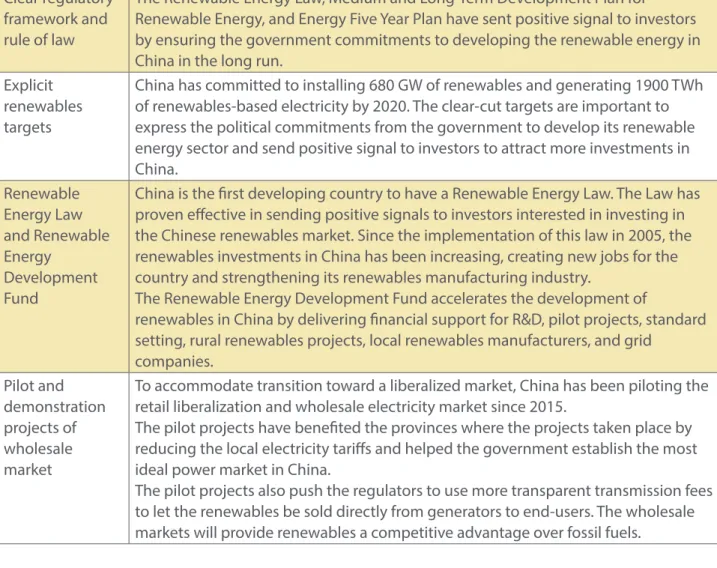
Lesson Learned
From the policies used to tackle the barriers and its implementation process, there are important findings that can be derived as a lesson for Indonesia. The R&D activities have proven effective in bringing down the cost of renewable energy, increasing the technological capability of local renewable energy producers, and improving the competitiveness of Chinese renewable energy technologies in the global market. The Indonesian government should take similar steps by providing funding for universities, research institutions and companies to carry out R&D and industrialization of key renewable technologies.
To be effective, FiT policy must be supported by a favorable institutional and regulatory environment and also able to adapt to changes in the market. In Germany, the FiT policy started with fixed fees that were reduced every year and was eventually replaced by the fee from the auction. Meanwhile, the FiT in India is set by a committee using a formula that can accommodate all stakeholders' interests.
The renewable energy portfolio is also targeted to each state using the Renewable Purchase Obligation (RPO) policy.
Recommendations
Financing Instruments for
Renewable Energy Development
To see significant growth in renewable energy, Indonesia must try new approaches to stimulate the market. The following are some funding sources that will help the country reach its 23% renewable energy target. The idea is to pool these funding sources into the Renewable Energy Fund (REF), which will be used to support the development of renewable energy in Indonesia.
There are four types of coal produced in Indonesia, low, medium, high and very high calorific value coal. While most of the coal produced in Indonesia contains low and medium calorific value, the other types also have a significant share of the market. Scenario 1: imposition of a progressive tax rate on coal production ranging from 1% to 4% of the coal reference price (Harga Batubara Acuan/HBA in USD per ton).
Scenario-2: imposition of a fixed tax rate of 3% of the coal reference price regardless of the calorific value of coal. By implementing the above scenarios in the RUEN projection of coal production, Indonesia will have approx. USD 525-572 million (scenario 1) or USD 881-966 million. (scenario 2) or USD million By implementing the above scenarios in the fuel consumption projection of the Ministry of Energy and Mineral Resources Planning, the collected fuel tax can reach about USD 622 million (Scenario 1) or USD 871 million (Scenario 2) or USD 1770 million (Scenario 3).
In addition to increasing the share of renewable energy in the power market, the fuel tax will also help Indonesia limit oil imports (and thus fuel oil subsidies), encourage people to use oil more efficiently, stimulate car manufacturers to develop fuel-efficient vehicles, and encourage people to use public transport more. These non-subsidized customers can be charged with surcharge that will be used for renewable development.
Formation of Renewable Energy Fund
The industrial and commercial consumers are not burdened with the surcharge to maintain Indonesia's competitive position against other countries. The loan facility will subsidize local banks to provide low-interest loans to renewable energy developers. The Guarantee Facility is responsible for providing credit guarantees to local banks on behalf of renewable energy developers.
Finally, the Clean Energy Development Fund will pay grants directly to strategic renewable energy projects in Indonesia. The REF would help Indonesia solve most of the problems currently faced by developers in developing renewable energy sources in the country.
Establishing an Independent Regulator
Creating priced-based policy instruments
AND CHAPTER 2
Retrieved from https://www.pwc.com/id/en/energy-utilities-mining/assets/power/power-survey-2017. Deloitte/global/Documents/Energy-and- Resources/gx-er-market-reform-germany.pdf Federal Ministry for Economic Affairs and Energy.
CHINA
National Development and Reform Commission, Ministry of Finance, Notice of the National Energy Administration on issues related to photovoltaic energy production in 2018]. Coal Transition in China's Power Sector: An Assessment of Stranded Assets and Plant-Level Retirement Pathways.
INDIA
Retrieved from https://mnre.gov.in/file-manager/grid-solar/100000MW-Grid-Connected-Solar-Power-Projects-by-2021-22.pdf.
Appendix A – History of Energiewende
Appendix B – Renewable Energy Sources Act
Appendix C – Subsidy and Incentive for Energy Storage (Battery) in Grid-Connected Solar PV System
